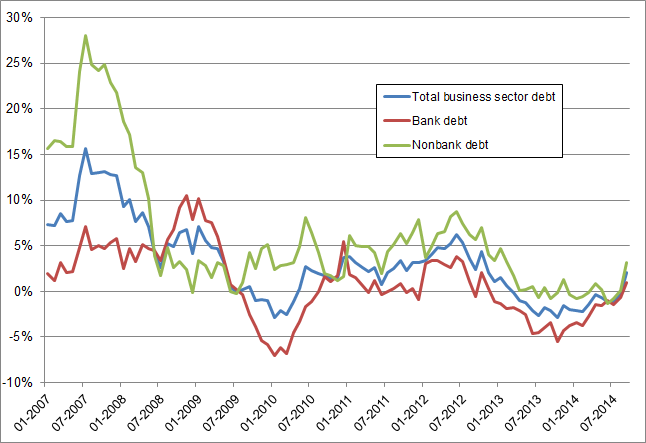Business sector debt increased by about 1.7 percent to around NIS 794 billion in September. Household debt increased by about NIS 2.9 billion (0.7 percent) to around NIS 428 billion at the end of the month.
The business sector’s outstanding debt
- The total outstanding debt of the business sector increased by about NIS 13 billion (1.7 percent) to around NIS 794 billion in September. The increased derived mostly from the depreciation of the shekel against the dollar by about 3.6 percent, which increased the shekel value of debt indexed or denominated in foreign currency, and from net raising of debt that resulted from taking out bank loans and the issue of tradable bonds in Israel totaling about NIS 6.2 billion.
- In the past two months, there has been a marked increase in the total outstanding debt of the business sector, both in bank debt and in nonbank debt. Total outstanding bank debt (credit from the banks and business sector bonds held by the banks) increased in August and September by about NIS 8.2 billion, following a recent trend of decline. About half of the increase is the result of net raising of debt. Total outstanding nonbank debt increased in the past two months by about NIS 15.4 billion, with only NIS 4 billion being the result of net raising of debt, and the rest resulting from the effect of the depreciation of the shekel against the dollar.
- In October, the business sector (excluding banks and insurance companies) issued about NIS 0.6 billion in bonds, most of which were tradable bonds. This was significantly lower than the average amount of issuances over the first nine months of the year, which is about NIS 3.6 billion per month.
Table 1: The Composition of Business Sector Debt

Figure 1: Rate of Change (Year on Year) in the Business Sector's Bank and Nonbank Debt

Table 2: Debt by Indexation

Figure 2: Business Sector Bond Issuance

Household debt
- Households’ outstanding debt increased by about NIS 2.9 billion (0.7 percent), to about NIS 428 billion, in September. Of that, the balance of outstanding housing debt increased by about NIS 1 billion, to about NIS 299 billion at the end of September. Since the beginning of the year, total housing credit has increased by about 4 percent.
- In October, the decline in new mortgages taken out continued, with the total reaching about NIS 3.5 billion (see Figure 3). The average over the first nine months of the year is about NIS 4.3 billion per month.
Table 3: Outstanding Debt Balances of Households

Figure 3 :Total Housing Credit from Banks, According to Indexation: New Mortgage Volume

The cost of the debt
- In September, the interest rate spread in the unindexed track narrowed by about 0.05 percentage points, as a result of a larger decline in interest rates on outstanding credit than in the interest rate on deposit balances.
- In the CPI-indexed track, the spread between the interest rate on new bank credit granted and the interest rate on deposits narrowed by about 0.31 percentage points in September, compared with the previous month.
- In September, the average spread between the yield on CPI-indexed corporate bonds—measured by the Tel Bond 60—and the yields on CPI-indexed government bonds was about 1.44 percentage points, similar to the spread in August. In October, this spread increased by about 0.05 percentage points.
- In October, the average interest rate on new unindexed mortgages (variable-rate interest) remained virtually unchanged. The average interest rate on new CPI-indexed mortgages (fixed interest) declined by about 0.07 percentage points.
Table 4: The Cost of the Debt

Figure 4 : Spread between Indexed Corporate Bonds (Tel-Bond 60) and Indexed Government Bonds (monthly average)

Figure 5 : New Housing Loans from Banks – Interest Rates in the Unindexed Sector

Figure 6 : New Housing Loans from Banks – Interest Rates in the CPI-indexed Sector

For links to Data and Statistics on the Bank of Israel website: